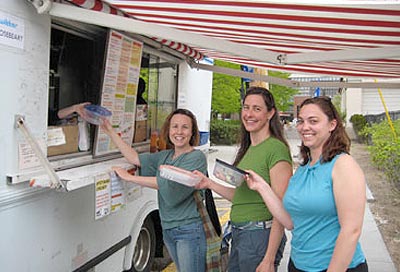
Jessica E. Garrett was already giving her Edgerton Center colleagues tips on going green—take the stairs, bring reusable containers to the lunch trucks, turn off lights—when she found out about a new Campus Energy Task Force program aimed at promoting sustainable practices on campus. Now, when she jokingly makes her co-workers earn the right to display “I walk the talk” postcards on their office doors, Garrett is performing her duty as a Green Ambassador.
The Green Ambassadors program creates and empowers a network of student, staff, and faculty volunteers to promote sustainable practices. Energy conservation, green purchasing, alternative transportation—the sky’s the limit, so long as it makes MIT a little greener.
“The Green Ambassadors program seeks to help establish MIT as a model of community-engaged sustainability through strengthening our sustainability community, providing and sharing critical information and knowledge, driving ‘place-based’ action, supporting collaboration, and sharing best practices,” says Steven M. Lanou, deputy director for environmental sustainability and a member of the Campus Energy Task Force of the MIT Energy Initiative.
There are currently 172 Green Ambassadors across campus. One of them is Peter H. Fisher, professor of physics. “I try to keep people off airplanes. I move printers to where they are inconvenient so people print less. I put the recycling bin near the desk and the regular wastebasket on the other side of the room,” he says. “Central is my belief that living well and living sustainably are deeply related.”
The Green Ambassadors program helps individuals share information and enables best practices that can make a difference. “At a basic level, Green Ambassadors show by example the choices and practices that can be adopted to have an impact,” Lanou says. His office coordinates the development of outreach and educational material as well as networking tools. Lanou’s staff, along with an active and engaged steering committee of student and staff volunteers, hosts events to strengthen the network and helps Green Ambassadors identify “greening” opportunities.
Expanding on past success
The Green Ambassadors program is an outgrowth of campus working groups in recycling and other initiatives that have been in existence for as long as 10 years, according to Niamh Kelly, assistant officer for the Environment, Health, and Safety Office (EHS), who has been working with Lanou to develop the program.
Students who helped set the stage for the program include Pamela Lundin, graduate student in chemistry, and Jialan Wang, graduate student in financial economics. Founders of the student group “Closing the Loop,” Lundin and Wang spearheaded a recent pilot project that slashed after-hours electricity use in Buildings 16 and 56.
“There have been ‘greening’ initiatives on campus for a long time, but without a name,” Kelly says. “The ambassadors program is a little broader than previous efforts because it includes elements such as purchasing and green events—and is sponsored by an Institute-wide initiative.”
In response to requests such as “What can we do in our office?” Kelly and Lanou took their show on the road with presentations that have since turned into handouts about topics such as how to increase energy efficiency and recycling and how to set computers, monitors, and printers on energy-saving modes. Using their own N52 officemates as guinea pigs, Kelly and Lanou post sustainability-related news on bulletin boards, print double-sided, and vanquish screen savers, Kelly says. Lanou plans to post data on how much energy is consumed daily by the EHS copy machines, computers, and water coolers.
“As individuals, we often feel powerless to make an impact on global climate change. When an individual switches to a better practice, the impact is multiplied as others learn of and adopt the new practice. When individual action becomes collective action, the aggregate can have a very large cumulative impact,” Lanou says.
Breaking down barriers
According to Kat A. Donnelly, an Engineering Systems Division graduate student researching behavior change and energy efficiency who presented her findings at a Green Ambassadors event during Independent Activities Period 2010, one of the reasons people don’t conserve energy may be the fact that energy is invisible—there’s no feedback from the system on how much we’re using.
Donnelly advocates an approach called community-based social marketing, which focuses on behavior change. Equally effective in offices, dormitories, and laboratories, social marketing involves putting yourself in other people’s shoes to understand their biases and determine the probability and potential impact of key behavior changes. In this way, she says, Green Ambassadors can help uncover barriers to saving energy and design approaches to break down those barriers.
Social marketing relies on incentives and education—tactics now being used by MIT ambassadors. The Campus Energy Task Force has launched educational strategies such as poster and e-mail campaigns that quantify the savings associated with using revolving doors, closing lab fume hoods when not in use, and turning off lights. “We provided some hard data that would answer the questions a typical MIT campus member would ask,” Kelly says.
Garrett, the Edgerton Center instructor and Green Ambassador, knows the value of incentives. She publicly acknowledges and congratulates her “green” colleagues at staff meetings—a tactic Donnelly would applaud. “It’s cheesy, but it does get people telling me what they are doing and thinking of ways they could make more changes. Amazing what people will do for a free postcard.” And, she might add, a chance to help save the planet.
This article appears in the Spring 2010 issue of Energy Futures.